Eye is the organ of sight. It is our most important organ for finding out about the world around us. We use our eyes in almost everything we do—reading, working, recognizing faces, watching movies and television, playing games, and countless other activities. Sight is our most precious sense, and many people fear blindness more than any other disability.
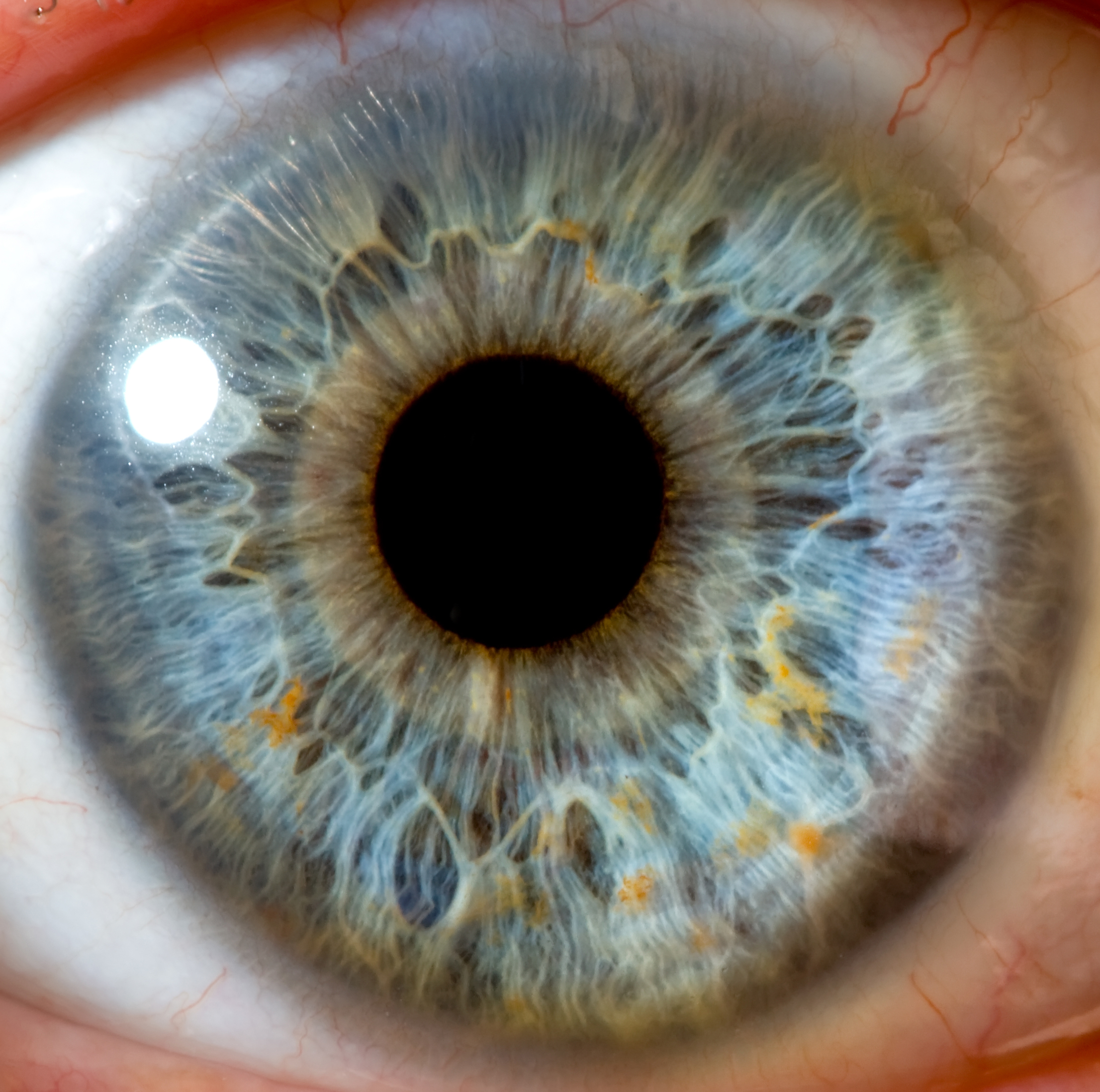
The human eyeball measures only about 1 inch (25 millimeters) in diameter. Yet the eye can see objects as far away as a star and as tiny as a grain of sand. The eye can quickly adjust its focus between a distant point and a near one. It can be accurately directed toward an object even while the head is moving.
The eye does not actually see objects. Instead, it sees the light they reflect or give off. The eye can see in bright light and in dim light, but it cannot see in no light at all. Light rays enter the eye through transparent tissues. The eye changes the rays into electrical signals. The signals are then sent to the brain, which interprets them as visual images.
Parts of the eye
Each eyeball is set in a protective cone-shaped cavity in the skull. This cavity is called the orbit or socket. Its ridges form the brow and the cheekbone. Fatty tissue inside the orbit nearly surrounds the eyeball and cushions it. The soft tissue also enables the eye to turn easily in the orbit. Six muscles move the eyeball in much the same way that strings move the parts of a puppet.
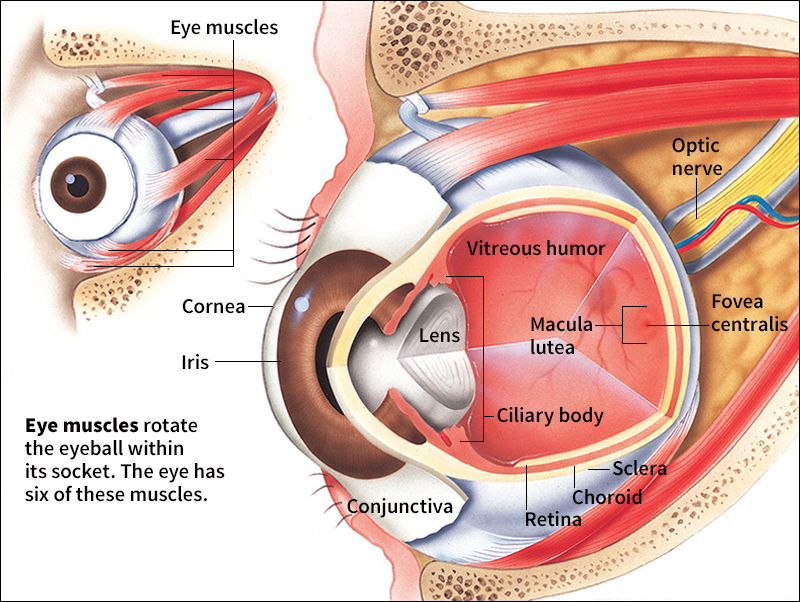
Around the eye are the eyelids, the conjunctiva, the lacrimal glands, and the lacrimal sac. Three layers of tissue form the wall of the eyeball: (1) the sclera and the cornea, (2) the uveal tract, and (3) the retina. Inside the eyeball is a clear, jellylike substance called the vitreous humor. This substance occupies about 80 per cent of the eyeball. It helps maintain the shape of the eye and the pressure within the eyeball.
The outer parts.
The front of the eyeball is protected by the eyelids. Eyelashes on the lids screen out some of the dust and other particles that might otherwise enter the eye. Any sudden movement in front of the eye—or anything that touches the eyelashes—causes the lids to blink in a protective reflex action.
The conjunctiva is a membrane that lines the inside of the eyelids and extends over the front of the white part of the eye. It produces mucus, a clear, slimy fluid that lubricates the inside of the eyelid and the outside of the eyeball. The conjunctiva also produces some tears, which help keep the eye moist and clean. However, most tears are made by the lacrimal glands. A lacrimal gland lies at the upper outer corner of each orbit. Every time a person blinks, the eyelids spread a smooth layer of mucus and tears over the eye. These fluids then flow into tiny canals in the lids. The canals lead to the lacrimal sac, a pouch at the lower inner corner of each orbit. From the lacrimal sac, the mucus and tears drain through a passage into the nose. After crying, a person may have to blow the nose to clear this drainage system of the excess tears.

The sclera and the cornea
consist of tough tissues that make up the outer layer of the eyeball and give it strength. The sclera covers about five-sixths of the eyeball, and the cornea about one-sixth. The sclera is the white part of the eye. It has the strength and feel of soft leather. Although the sclera appears to have many blood vessels on its surface, most of these vessels are part of the conjunctiva. The cornea has no blood vessels at all and has relatively little internal moisture. As a result, it is transparent. The cornea lies in front of the colored part of the eye and resembles the crystal of a wrist watch. The cornea enables light rays to enter the eyeball.
The uveal tract
is the middle layer of the wall of the eyeball. It has three parts. They are, from front to back: (1) the iris, (2) the ciliary body, and (3) the choroid.
The iris
is the colored disk behind the cornea. The color of the iris comes from a brownish-black substance called melanin. The more melanin there is and the closer it is to the surface of the tissue, the darker the color of the iris. For example, there is more melanin in brown eyes—and the melanin is closer to the surface—than in blue eyes. In addition to giving the iris color, melanin absorbs strong light that might otherwise dazzle the eye or cause blurred vision. Melanin is the same substance found in freckles and that gives skin and hair their color. People with albinism have little or no melanin. They may have milky-white skin, white hair, and blue or translucent irises. Poor vision and sensitivity to light are common in people with albinism (see Albinism).
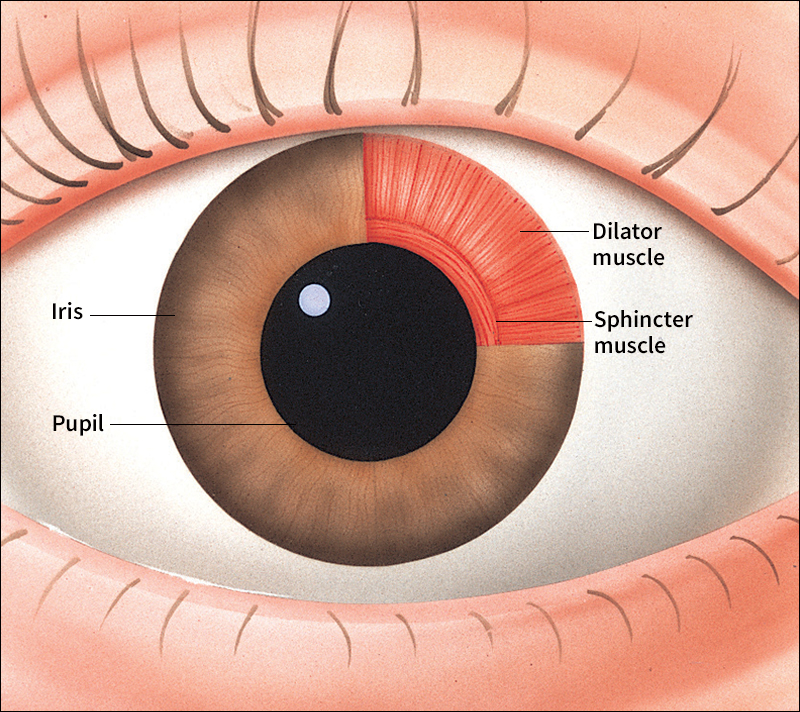
At the center of the iris is a round opening called the pupil, which looks like a black circle. The size of the pupil regulates the amount of light that enters the eye. Two muscles in the iris automatically adjust the size of the pupil to the level of light. In dim light, the dilator muscle enlarges the pupil. As much light as possible can then enter the eye. In bright light, the sphincter muscle makes the pupil smaller, which prevents too much light from entering the eye. The pupil also becomes smaller when the eye looks at a nearby object, thus bringing the image into sharp focus.
The ciliary body
encircles the iris. It is connected by strong fibers to the crystalline lens, which lies directly behind the iris. The lens is a flexible structure about the size and shape of an aspirin tablet. Like the cornea, the lens is transparent because it has no blood vessels and is relatively dehydrated. The muscles of the ciliary body make constant adjustments in the shape of the lens. These adjustments produce a sharp visual image at all times as the eye shifts focus between nearby and distant objects. The ciliary body also produces a clear, watery fluid called aqueous humor. This fluid nourishes and lubricates the cornea and the lens, and it fills the area between them. The ciliary body produces aqueous humor continuously. The old fluid flows into a drainage system at a spongy, circular groove where the cornea and the sclera meet. It then travels through the veins of the conjunctiva into the veins of the neck.
The choroid
forms the back of the uveal tract. It looks and feels like a blotter soaked with black ink. The choroid has many blood vessels. Blood from the choroid nourishes the outer part of the retina.
The retina
makes up the innermost layer of the wall of the eyeball. It is about as fragile as a piece of wet tissue paper. Light-sensitive cells in the retina absorb light rays and change them into electrical signals. There are two types of these light-sensitive cells—rods and cones. The cells are named for their shape. The retina has about 120 million rods and about 6 million cones. Other cells in the retina, called intrinsically photosensitive retinal ganglion cells (ipRGC’s), detect light and help identify images.
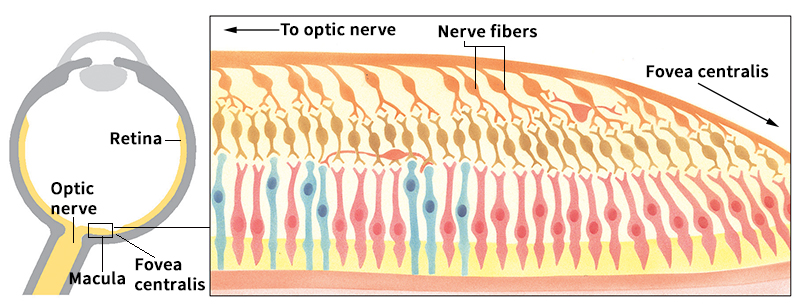
Bits of pigment (colored material) in the rods and cones absorb even the smallest particle of light that strikes the retina. The pigment in the rods is called rhodopsin or visual purple. It enables the eye to see shades of gray and to see in dim light. There are three types of pigment in the cones. They enable the eye to see colors and to see sharp images in bright light. Cyanolabe absorbs blue light. Chlorolabe absorbs green light. Erythrolabe absorbs red light. These pigments enable us to distinguish more than 200 colors.
Near the center of the retina is a round area called the macula lutea or macula. The macula consists chiefly of cones. It produces a sharp image of scenes at which the eyes are directly aimed, especially in bright light. The rest of the retina provides peripheral vision—that is, it enables the eyes to see objects to the side while looking straight ahead. Most of the rods lie in this part of the retina. Because rods are more sensitive in the dark than cones, faint objects often can be seen more clearly if the eyes are not aimed directly at them. For example, looking to the side of a dim star makes its image fall on the part of the retina that has the most rods and provides the best vision in dim light.
Nerve fibers attached to the rods and cones join at the center of the retina and form the optic nerve. This nerve consists of about a million fibers. It serves as a flexible cable that connects the eyeball to the brain. In fact, the optic nerve and the retina are actually extensions of the brain. The optic nerve carries the electrical signals produced in the retina to the brain, which interprets them as visual images.
The point where the optic nerve enters the eye is known as the blind spot. It has no rods or cones and therefore cannot respond to light. Normally, a person does not notice the blind spot because it covers such a small area and the eyes make so many quick movements. In addition, anything the blind spot of one eye cannot see is seen by the other eye. See Blind spot.
How we see
Focusing.
Light rays that enter the eye must come to a point on the retina for a clear visual image to form. However, the light rays that objects reflect or give off do not naturally move toward one another. Instead, they either spread out or travel almost parallel. The focusing parts of the eye—the cornea and the lens—bend the rays toward one another. The cornea provides most of the refracting (bending) power of the eye. After light rays pass through the cornea, they travel through the aqueous humor and the pupil to the lens. The lens bends the rays even closer together before they go through the vitreous humor and strike the retina. Light rays from objects at which the eyes are aimed come together at the fovea centralis, a tiny pit in the center of the macula. It is the area of sharpest vision. Light rays from objects to the sides strike more peripheral areas of the retina.
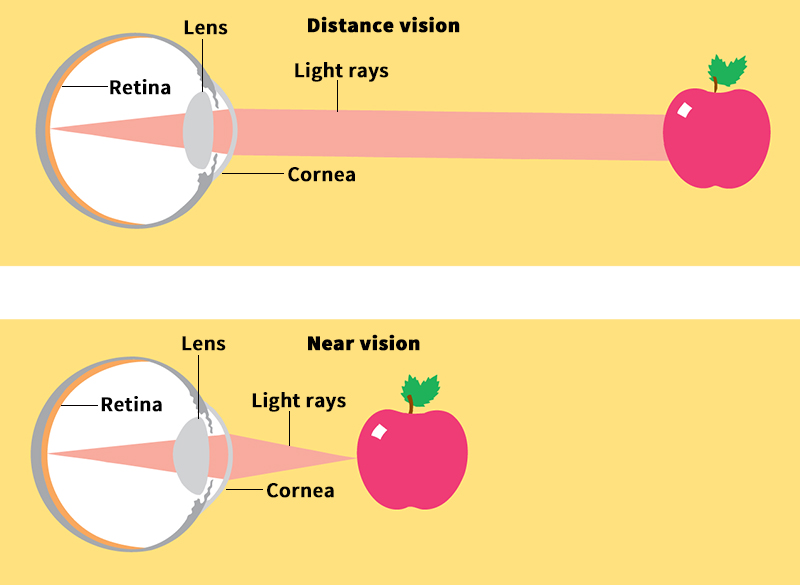
The refracting power of the lens changes constantly as the eye shifts focus between nearby objects and distant ones. Light rays from nearby objects spread out, and those from distant objects travel nearly parallel. Therefore, the lens must provide greater bending power for the light rays from nearby objects to come together. This additional power is produced by a process called accommodation. In this process, one of the muscles of the ciliary body contracts, thereby relaxing the fibers that connect the ciliary body to the lens. As a result, the lens becomes rounder and thicker and thus more powerful. When the eye looks at distant objects, the muscle of the ciliary body relaxes. This action tightens the fibers that are connected to the lens, and the lens becomes flatter. For this reason, the eye cannot form a sharp image of a nearby object and a distant one at the same time.
Depth perception
is the ability to judge distance and to tell the thickness of objects. The lens system of the eye, like the lens of a camera, reverses images. Thus, the images that form on the retina are much like those produced on film in a camera. The images are upside down and reversed left to right. They are also flat, as in a photograph. However, the brain interprets the images as they really are. The ability of the brain to interpret retinal images right-side up, unreversed, and in depth comes from experience that begins at a person’s birth.
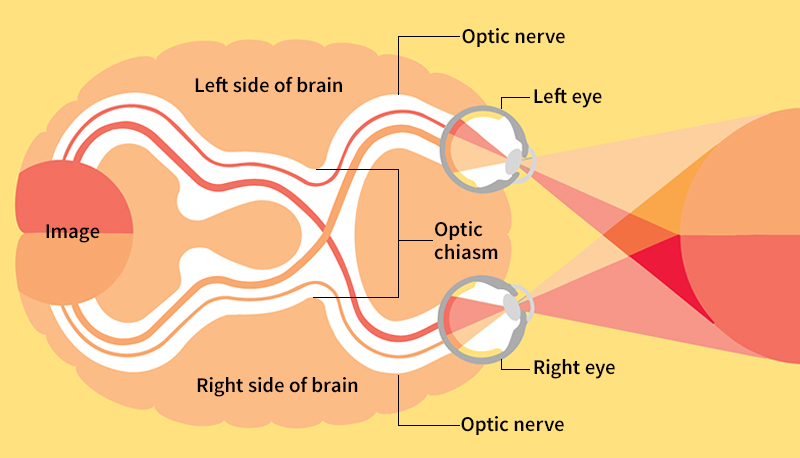
The optic nerves from the two eyes meet at the base of the brain at a point called the optic chiasm. At the optic chiasm, half the nerve fibers from each eye cross over and join the fibers from the other eye. Each side of the brain receives visual messages from both eyes. The nerve fibers from the right half of each eye enter the right side of the brain. These fibers carry visual messages from objects that are to a person’s left. The nerve fibers from the left half of each eye enter the left side of the brain. These fibers carry visual messages from objects that are to a person’s right. Thus, if one side of the brain becomes damaged, the opposite side of a person’s field of vision may be reduced. Such damage may occur as a result of a stroke, injury, or tumor.
The eyes are about 21/2 inches (6.4 centimeters) apart from center to center. For this reason, each eye sees things from a slightly different angle and sends slightly different messages to the brain. The difference can be demonstrated by focusing on a nearby object first with one eye closed and then with the other eye closed. The image seen with each eye is slightly different. The brain puts the images together and thus provides depth perception, also called stereoscopic vision or three-dimensional vision. The image formed by the brain has thickness and shape, and the brain can judge the distance of the object.
Normal depth perception requires that the eyes work together in a process called binocular vision or fusion. In this process, the eye muscles move the eyes so that light rays from an object fall at a corresponding point on each retina. When viewing objects close up, the eyes turn slightly inward. When viewing distant objects, the eyes are almost parallel. If images do not fall at a corresponding point on each retina, they will be blurred or be seen as double, or the brain will ignore one of them.
In most people, visual messages are stronger in one eye and on one side of the brain than the other. Most people are “right-eyed” or “left-eyed,” just as they are right-handed or left-handed. For example, they favor one eye or the other when aiming a camera or a rifle.
Adaptation to light and dark
is partly controlled by the pupil. In strong light, the pupil may become as small as a pinhead and so prevent the eye from being damaged or dazzled by too much light. In the dark, it can get almost as large as the entire iris, thus letting in as much light as possible. However, the most important part of adaptation to light and dark occurs in the retina. 
Light rays are absorbed by pigments in the retina’s rods and cones. The pigments consist of protein and vitamin A. Vitamin A helps give the pigments their color. The color enables the pigments to absorb light. Light changes the chemical structure of the vitamin A and bleaches out the color in the pigments. This process generates an electrical signal that the optic nerve transmits to the brain. After the pigments have been bleached, the vitamin A moves into a part of the retina known as the retinal pigmented epithelium (RPE). The vitamin regains its original chemical structure in the RPE and then returns to the rods and cones. There, it joins with protein molecules and forms fresh pigments.
The renewal of rhodopsin—the pigment that enables the eye to see in dim light—occurs largely in the dark. Immediately after being exposed to bright light, the eyes cannot see well in dim light because of the bleached rhodopsin. It takes about 10 to 30 minutes for rhodopsin to be renewed, depending on how much was bleached. During this time, the eyes become accustomed to the dark.
The cone pigments, which provide sharp vision in bright light, take less time than rhodopsin to be renewed. The eyes become accustomed to bright light much quicker than they do to darkness. The adaptation from darkness to light depends largely on changes in the retina’s nerve cells.
Defects of the eye
Defects of the eye are among the most common of all physical disorders. Certain defects cannot be cured, but vision can be improved by means of eyeglasses, contact lenses, or surgery. The most common defects of the eye include (1) nearsightedness, (2) farsightedness, (3) astigmatism, (4) strabismus, and (5) color blindness. A type of surgery called LASIK (_la_ser in _si_tu _k_eratomileusis) can correct nearsightedness, farsightedness, and astigmatism. In this surgery, a laser is used to reshape the cornea.
Loading the player...Nearsightedness and farsightedness
Nearsightedness,
also called myopia, is characterized by blurred distance vision, though near vision remains sharp except in extreme cases. In most cases of nearsightedness, the eyeball is too long from front to back. As a result, light rays from distant objects meet before they reach the retina. When the light rays do strike the retina, they form a blurred image. Eyeglasses or contact lenses that are concave bring the light rays together at the retina and correct most cases of nearsightedness. Concave lenses are thinner in the middle than at the edges. See Myopia.
Farsightedness,
also called hyperopia, occurs in most cases because the eyeball is too short from front to back. Unless the lens accommodates, light rays from distant objects reach the retina before they meet, causing a blurred image. The lens of a normal eye remains relatively flat for distance vision and becomes thicker for nearby objects to be brought into focus. In a farsighted eye, however, the lens must also thicken for sharp distance vision. The retina of the farsighted eye therefore receives sharp images of distant objects. But the constant use of the muscles of the ciliary body to adjust the shape of the lens may cause eyestrain and headaches. In addition, the lens sometimes may not thicken enough for sharp near vision. Glasses or contact lenses that are convex correct farsightedness. Convex lenses are thicker in the middle than at the edges. See Farsightedness.
Between the ages of 40 to 50, a person’s lens begins to harden and to lose its ability to thicken. This condition is called presbyopia, and it affects nearly all middle-aged and elderly people. By the time a person is about 60, the lens has almost no flexibility and can barely accommodate. Because of presbyopia, most middle-aged and elderly people need glasses for reading and close work. If they wore glasses before, they may need new glasses with bifocal lenses.
Astigmatism
is usually caused by a misshapen cornea. As a result of the abnormal shape, all the light rays from an object do not come together at one point on the retina. Some rays may focus on the retina. But others may meet before they reach the retina, or they may reach the retina before they meet. Most cases of astigmatism produce blurred vision both nearby and at a distance. In mild cases, there may be eyestrain and headaches but fairly sharp vision. Astigmatism may be combined with nearsightedness, farsightedness, or presbyopia. To correct astigmatism, doctors prescribe glasses or contact lenses that have cylindrical components. Cylindrical lenses have greater bending power in one axis than in others. See Astigmatism.
Strabismus
is a defect in which the eyes are not used together. One of the eyes is deviated (turned too far in one direction) all or part of the time. In most cases, the deviated eye is turned either toward the nose, a condition called cross-eye, or toward the side, a condition called walleye. Strabismus occurs most often in young children. In children with strabismus, each eye sees a different part of a scene and sends a greatly different message to the brain. In most cases, the brain tends to ignore the weaker message—the one from the deviated eye. Blurring or double vision also may occur. Many cases of strabismus can be corrected if detected early. Strabismus may be treated by means of glasses, eye drops, surgery on the muscles of one or both eyes, or a patch worn for a time over one of the eyes—in most cases, the nondeviated one. Unless strabismus is corrected early, vision in the deviated eye may be permanently reduced. This condition is called strabismic amblyopia or lazy eye. See Strabismus.
Color blindness,
also called color vision deficiency or color-defective vision, refers to difficulty telling colors apart. Very few people are unable to distinguish colors at all. In most cases of color blindness, certain colors are confused with others. For example, a green object may appear brown. Color blindness is caused by abnormalities in the pigments of the retina’s cones. Nearly all color blindness is present at birth. More males than females are color blind. The condition cannot be corrected, but it does not get worse. See Color blindness.
Diseases of the eye
Disease may affect any part of the eye. Eye diseases cause a great majority of all blindness. Injuries cause the rest. Eye diseases include (1) cataract, (2) glaucoma, (3) diseases of the cornea, (4) diseases of the sclera, (5) diseases of the uveal tract, (6) diseases of the retina, (7) diseases of the optic nerve, and (8) diseases of the outer parts of the eye.
Cataract
is a condition in which part or all of the lens becomes clouded. The clouded part of the lens is also called a cataract. Severely reduced vision—or even partial blindness—results if the cloudiness covers a large area, is dense, or is at the center of the lens. However, some cataracts cause little or no loss of vision. Most cataracts result from aging. If a cataract causes enough loss of vision that it interferes greatly with a person’s daily activities, the lens is removed by surgery. In most cases, surgeons replace the diseased lens with a plastic intraocular lens or with contact lenses. See Cataract.
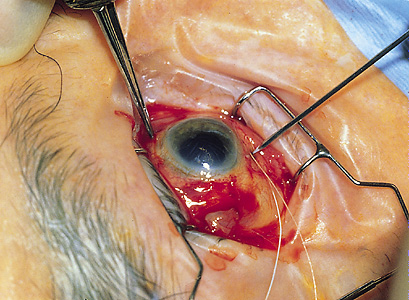
Glaucoma
is a disease in which the pressure in the eye is too high for the health of the optic nerve. Sometimes, the aqueous humor—the fluid that nourishes the cornea and the lens—does not drain properly. Pressure in the eye can increase and, if untreated, can destroy the optic nerve. In primary open-angle glaucoma, the most common type, vision to the side gradually narrows, and total blindness may eventually result. Primary open-angle glaucoma occurs chiefly in people over 40 years old. It is also called chronic simple glaucoma. It goes unnoticed by most people until some vision is lost, though a physician can detect the disease shortly after it develops. Physicians treat open-angle glaucoma with eye drops or laser therapy. Such treatments reduce pressure in the eye and so halt damage to the optic nerve. Most patients must use the eye drops throughout life, and some will require periodic laser treatments. If these therapies are not effective, a new drainage channel for the aqueous humor is surgically made or the old channels are surgically reopened.
A type of glaucoma called primary narrow-angle glaucoma or acute glaucoma may occur suddenly at any age. Its symptoms include pain in the eyes or forehead and seeing halos or rainbows around lights. Immediate surgery or laser treatment may be necessary to prevent blindness. See Glaucoma.
Diseases of the cornea
are among the most common eye disorders. The cornea has less protection than any other part of the eyeball. It may be accidentally scratched by an overworn contact lens, by a fingernail, or by a particle that flies into the eye, and a painful infection can result. Inflammation of the cornea may be caused by the herpes simplex virus, the same virus that causes cold sores. Physicians treat infections of the cornea with antibiotics, often in the form of drops or ointments.
A disease called keratoconus leads to a deformed cornea. As the disease progresses, the cornea becomes cone-shaped. In the early stages, keratoconus can be treated with glasses or contact lenses. In severe cases, the cornea may be removed by surgery and replaced with a cornea from a person who recently died. The replacement comes from an agency called an eye bank (see Eye bank). This operation is known as a corneal transplant or corneal graft and is used to treat many disorders that cause diseased corneas.
Diseases of the sclera,
the white part of the eye, are relatively uncommon. Inflammation of the sclera is called scleritis. It is often caused by an infection or an allergy, but may also be associated with arthritis. Physicians usually treat scleritis with eye drops or pills.
Diseases of the uveal tract.
An inflammation of the uveal tract is called uveitis. Such diseases include iritis, inflammation of the iris; cyclitis, inflammation of the ciliary body; and choroiditis, inflammation of the choroid. In many instances, the cause of these diseases cannot be determined. Physicians treat such cases by prescribing medications that reduce the inflammation. The uveal tract may also be attacked by a cancerous tumor called a melanoma. Physicians may remove the tumor or the entire eye, or they may use other techniques, such as radiation treatments, to prevent the cancer from spreading.
Diseases of the retina.
A number of diseases can damage the retina. One of the most common causes of blindness among adults is diabetic retinopathy, which affects some people who have chronic diabetes. After many years of diabetes, the blood vessels of the retina may leak, close up, or begin to grow. These conditions may cause blood to enter the vitreous humor, the clear, jellylike fluid inside the eyeball. The blood makes the vitreous opaque (nontransparent), causing blindness. In some cases, a major surgical procedure called a vitrectomy can remove the blood and restore vision. In another procedure, a narrow beam of light from a laser destroys the abnormal vessels of the retina before blood enters the vitreous.
Diabetic retinopathy—and many other disorders of the eye—can also result in a detached retina. In this condition, the retina pulls away from the choroid. A detached retina can be corrected surgically by indenting the wall of the eyeball so that the choroid meets the retina. If this procedure is successful, the retina then remains attached to the choroid. Vitrectomy can also be used to reattach the retina.
One of a group of diseases called macular degeneration may affect the macula, the part of the retina responsible for sharp central vision. The patient loses the ability to see objects at which the eyes are directly aimed, though vision to the side remains. Some cases of macular degeneration are inherited. The most common form, called age-related macular degeneration (AMD), appears in old age. Special magnifying devices enable some patients to see well enough to read. There are two major types of macular degeneration. Dry macular degeneration, in which the macular tissue wastes away with age, can be treated with specific vitamins, antioxidants, and minerals. Wet macular degeneration, in which abnormal and leaky blood vessels grow in the macula, can be treated with lasers and through the regular injection of certain medications directly into the vitreous jelly. These medications act by interfering with the growth of blood vessels in the macula.
A group of diseases called retinitis pigmentosa chiefly affects the rods and cones of the retina. One of the first symptoms is night blindness, in which a person sees poorly or not at all in dim light or at night. Many patients lose vision to the side and are left with only tunnel vision. Some gradually become blind. In numerous cases, retinitis pigmentosa is inherited. Vitamin A, taken in high doses under medical supervision, has been found to slow the progression of some aspects of this group of diseases.
Cancer of the retina is called retinoblastoma. In many cases, it is inherited and a tumor forms in the retina in early childhood. Doctors treat the disease with drugs or, in some cases, X rays. Some patients must have the eye removed.
A blood disease called sickle cell anemia, which occurs chiefly among blacks, damages many parts of the body and may eventually result in death. As the disease develops, it can cause a condition known as sickle cell retinopathy. In this condition, the blood vessels of the retina may clot and then may begin to grow and bleed. Blindness may result. Some cases of sickle cell retinopathy can be treated successfully by means of a laser or by eye surgery. See Sickle cell anemia.
A condition called retinopathy of prematurity can occur in some premature infants. Immediately after birth, premature infants are sometimes placed in incubators, which provide warmth and a high level of oxygen. However, the incubator’s high oxygen level may contribute to abnormal development of the blood vessels of the retina in some infants. This condition can lead to permanently reduced vision or even blindness. Physicians may use laser treatments or a surgical technique called cryotherapy to treat retinopathy of prematurity. Cryotherapy involves freezing part of the eye in order to stop or slow the growth of abnormal tissue in the retina.
Diseases of the optic nerve.
The optic nerve can be damaged by optic neuritis (inflammation of the optic nerve), tumors, infection, and other diseases. Not all diseases of the optic nerve can be treated.
Diseases of the outer parts.
Various diseases can affect the outer parts of the eye. A sty is an infection of one of the sacs from which the eyelashes grow. A sty looks like a pimple on the edge of the eyelid. Sties may be treated by applying a moist, warm cloth and with prescribed antibiotics. In some cases, pus from a sty may have to be drained by minor surgery. See Sty.
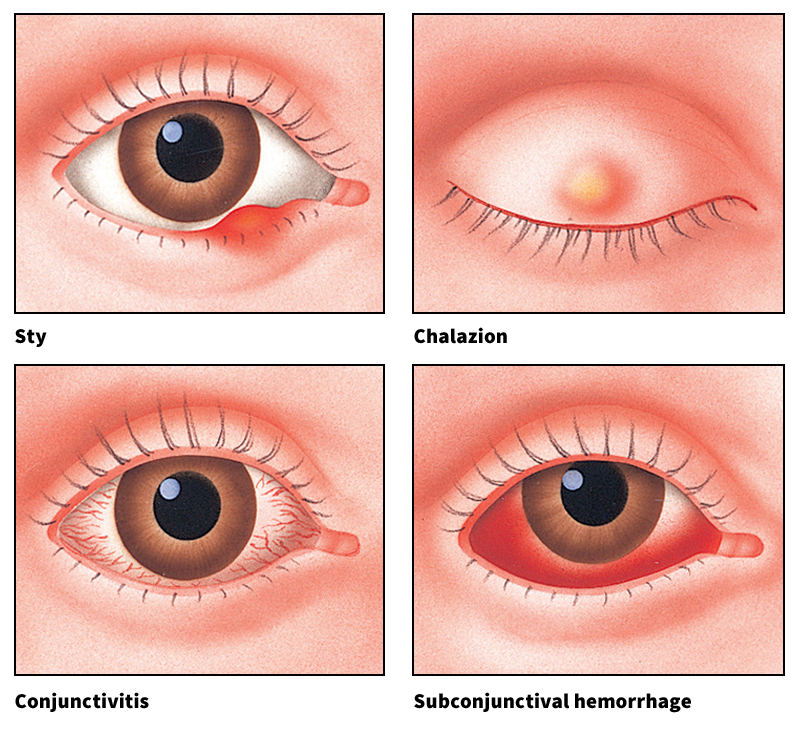
A chalazion is a blocked gland along the inside of the eyelid. If the gland becomes infected, a lump may form under the lid. The infected gland is treated the same way as a sty. After the infection clears up, the chalazion may be removed by minor surgery.
Conjunctivitis is an inflammation of the conjunctiva, the membrane that lines the eyelids and covers part of the eyeball. Some types of conjunctivitis are called pinkeye. The disease may be caused by an infection, by an allergy, or by such substances as smoke or smog. The eyes become red and watery, and pus may form. Many types of conjunctivitis are contagious. They are often spread when someone uses the same towel or swims in the same swimming pool as a person who has the disease. Doctors often treat conjunctivitis with eye drops. They also may advise patients to take precautions so as to avoid infecting others. See Conjunctivitis.
A severe form of conjunctivitis called trachoma is caused by a microscopic organism. The disease is treated with drugs or surgery or both. Trachoma is a rare disease in the industrialized world, but it is a leading cause of blindness in many less developed countries. See Trachoma.
Care of the eye
Preventing eye damage.
The most common injuries are caused by blows to the eye, by particles that enter the eye, and by chemical burns, explosions, and firearms. Many such injuries can be prevented. For example, safety glasses or goggles protect the eyes from particles that may be thrown from electric saws, grinding wheels, and other power tools. Some athletes also wear safety glasses to prevent eye injuries caused by balls, rackets, hockey pucks, and other sports equipment. In most cases, specks of dust or other particles that enter the eye can be removed by blinking gently or by flushing the eye with water. If the particle does not come out, it should be removed by a physician. A fragment of glass, metal, or wood—or any particle stuck on the cornea—also should be removed by a physician. If chemicals enter the eye, they should be washed out immediately with large amounts of water, and a physician should be consulted at once.
The eyes can also be damaged through improper use of contact lenses, eye makeup, and sun lamps. Infection may develop if contact lenses are not clean before they are inserted in the eyes. The hands also should be clean, and saliva should never be used to moisten the lenses before inserting them. People should not wear contact lenses longer than the time prescribed by the eye doctor. Eye infections also may result from sharing eye makeup or from moistening the cosmetics with saliva to apply them. The light of a sun lamp can cause painful burns of the cornea. Special goggles should be worn when using a sun lamp. No one should ever look directly at the sun, even during an eclipse.
Receiving regular eye examinations.
Doctors recommend that everyone have an eye examination shortly after birth and at least every few years until the age of 40. Thereafter, the eyes should be examined about once a year or every two years. Eye examinations may be given by an optometrist or by an ophthalmologist. Optometrists are licensed professionals who test vision and prescribe glasses and contact lenses. Ophthalmologists, also called oculists, are medical doctors who specialize in the eye. They test vision, prescribe glasses and contact lenses, and treat eye diseases by means of medication, lasers, and surgery. Opticians make and sell glasses and contact lenses prescribed by optometrists and ophthalmologists.
One of the most familiar parts of an eye examination tests visual acuity (sharpness of vision) at a distance. This test involves reading letters from a chart a certain distance away—usually 20 feet (6 meters). The letters of each line are smaller than those in the line above. A person who can read all the lines that a normal eye can see from 20 feet (6 meters) has normal visual acuity. This vision is expressed as 20/20 (6/6 in the metric system). A higher denominator indicates a visual defect. For example, a person with 20/40 (6/12) vision must be 20 feet (6 meters) from the chart to read all the lines that a normal eye can see from 40 feet (12 meters). Each eye is tested individually, and one eye may have better vision than the other. Optometrists and ophthalmologists also test near vision and side vision.
Ophthalmologists and optometrists also examine the inside of the eye for any sign of disease. By looking through the pupil with various instruments, these specialists can examine the blood vessels of the retina, the fibers of the optic nerve, and the health of the macula. The condition of these structures may indicate not only an eye disease but also the advance of such diseases as diabetes, high blood pressure, or macular degeneration. For this reason, physicians also look into the eye as part of a routine physical examination.
Eyes of animals
Most animals have organs of some kind that sense light. The most elementary of these organs are called eyespots. Eyespots are light-sensitive areas on the bodies of flatworms, starfish, and certain other invertebrates (animals without a backbone). The organs can distinguish between light and dark but cannot form images.
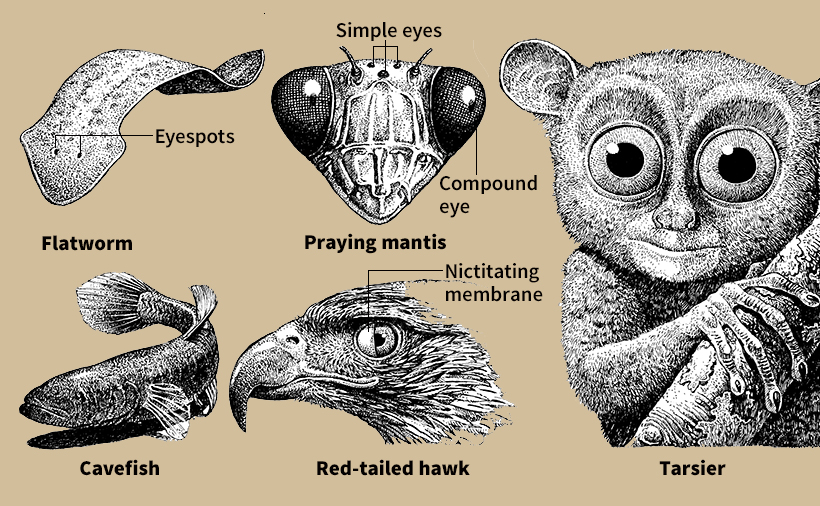
Other invertebrates have true eyes. Most kinds of insects have two large compound eyes. These eyes consist of many tiny lenses. Each lens admits light rays from one direction—one bit of the total scene that the insect sees. All the bits combine and form an image. Many adult insects also have three simple eyes set in a triangle between the compound eyes. Each simple eye has one lens. The simple eyes do not form images, but they respond to light quickly. Most crustaceans, such as lobsters, have two compound eyes, and many species also have a simple eye. Arachnids, insectlike animals that include spiders and scorpions, have only simple eyes.
The eyes of most vertebrates (animals with a backbone) have a structure similar to that of the human eye. However, the eyes may vary greatly in certain details. For example, many vertebrates that live in total darkness, such as in deep caves, have tiny eyes that can see little or nothing. On the other hand, owls and some other animals that hunt at night have extremely large eyes and pupils, which provide excellent vision in dim light. Cats also have good night vision. A mirrorlike structure in the eye called the tapetum lucidum reflects light onto the retina. The structure makes a cat’s eyes appear to glow at night when light is reflected off them.
Most birds have three eyelids—an upper lid, a lower lid, and a nictitating membrane, which moves sideways. The animals use the nictitating membrane to blink, and they close the upper and lower lids when sleeping. Birds have the best visual acuity of all animals, including human beings. For example, a vulture can see a dead animal on the ground from a height of up to 21/2 miles (4 kilometers).
